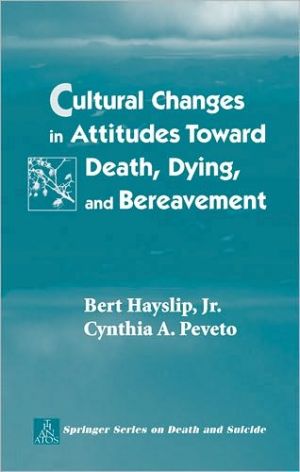Cultural Changes in Attitudes Toward Death, Dying, and Bereavement
"Bert Hayslip and Cynthia Peveto compare the findings from the landmark 1970s Kalish and Reynolds' Death and Ethnicity Study to their own present study and examine the impact of cultural change on death attitudes." Focusing on African-American, Asian-American, and Hispanic-American subpopulations with Caucasians treated as a comparison group, the authors explore the relation of previous results to the present. Several broad findings include: the shift toward more interest in being informed of...
Search in google:
Kalish and Reynold's work has formed the basis for thantological research from a multicultural perspective since they published their findings in 1976, but Hayslip (psychology, U. of North Texas) and licensed psychologist Peveto, wondered how relevant their findings were for the 21st century. Using the same instruments, they surveyed participants of similar demographic makeup residing in north Texas today, and compare the differences to reveal changes in cultural attitudes toward death during the past three decades. Annotation ©2004 Book News, Inc., Portland, OR Doody Review Services Reviewer:Kathy Tinius, EdD(Texas Woman's University)Description:This book outlines the findings of a current study focused on the cultural change in death attitudes and compares the findings to the 1970 Kalish and Reynolds's Death and Ethnicity Study.Purpose:The purpose is to provide a detailed summary of the earlier study and offer a follow-up study on how much American attitudes toward death have been changing. The objectives are worthy and the book meets the objectives through data analysis and broad findings.Audience:This book is written primarily for researchers, educators, and service providers interested in death-related issues. However, sociologists, anthropologists, and others studying culture will find the research informative. The authors are respected psychologists and credible authorities in the field.Features:The book examines the impact of cultural change on death attitudes by focusing on African American, Asian American, and Hispanic American subpopulations with Caucasians as the comparison group. Appendix A, Summary of Results by Ethnicity, Age, and Gender for the Present Study is very informative.Assessment:The book is well written and serves as a useful resource to those working with death related issues. The extensive references provide additional resources.
Foreword1Introduction12An overview of the death-ethnicity relationship : Kalish and Reynolds53Factors influencing death attitudes : Kalish and Reynolds234The impact of cultural change on death attitudes595The present study656Analysis of findings : intrastudy variability777Analysis of findings : interstudy variability858Hypotheses regarding interstudy and intrastudy variability979Discussion101App. ASummary of results by ethnicity, age, and gender for the present study131App. BChi square comparisons of Kalish and Reynolds' study with the present study's results on selected items175
\ Reviewer: Kathy Tinius, EdD(Texas Woman's University)\ Description: This book outlines the findings of a current study focused on the cultural change in death attitudes and compares the findings to the 1970 Kalish and Reynolds's Death and Ethnicity Study.\ Purpose: The purpose is to provide a detailed summary of the earlier study and offer a follow-up study on how much American attitudes toward death have been changing. The objectives are worthy and the book meets the objectives through data analysis and broad findings.\ Audience: This book is written primarily for researchers, educators, and service providers interested in death-related issues. However, sociologists, anthropologists, and others studying culture will find the research informative. The authors are respected psychologists and credible authorities in the field.\ Features: The book examines the impact of cultural change on death attitudes by focusing on African American, Asian American, and Hispanic American subpopulations with Caucasians as the comparison group. Appendix A, Summary of Results by Ethnicity, Age, and Gender for the Present Study is very informative.\ Assessment: The book is well written and serves as a useful resource to those working with death related issues. The extensive references provide additional resources.\ \ \ 4 Stars! from Doody\ \








